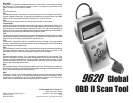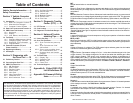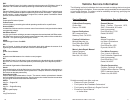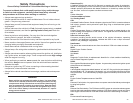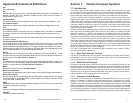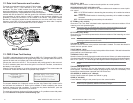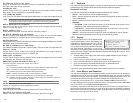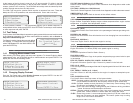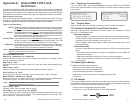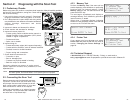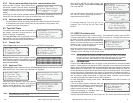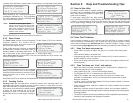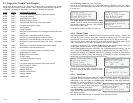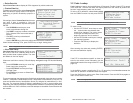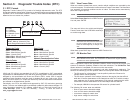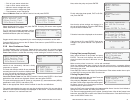
4 9620 Professional OBD II Scan Tool
Safety Precautions
General Safety Guidelines to Follow When Working on Vehicles
To prevent accidents that could result in serious injury and/or damage
to vehicle or test equipment, carefully follow these safety rules and
test procedures at all times when working on vehicles:
Always wear approved eye protection.
Always operate the vehicle in a well-ventilated area. Do not inhale exhaust
gases they are very poisonous!
Always keep yourself, tools and test equipment away from all moving or hot
engine parts.
Always make sure the vehicle is in Park (Automatic transmission) or neutral
(manual transmission) and that the parking brake is firmly set. Block the
drive wheels.
Never lay tools on vehicle battery. You may short the terminals together
causing harm to yourself, the tools or the battery.
Never use scan tool if its internal circuitry has been exposed to any liquids.
Never smoke or have open flames near vehicle. Vapors from gasoline and/or
charging battery are highly flammable and explosive.
Never leave vehicle unattended while running tests.
Always keep a fire extinguisher suitable for gasoline/electrical/chemical fires
handy.
Always use extreme caution when working around the ignition coil, distributor
cap, ignition wires, and spark plugs. These components contain high voltage
when the engine is running.
When performing a road test, never operate the scan tool alone while driving
the vehicle. Always have one person drive the vehicle while an assistant
operates the tester.
Always turn ignition key OFF when connecting or disconnecting electrical
components, unless otherwise instructed.
Always follow vehicle manufacturers warnings, cautions and service proce-
dures.
WARNING!
Some vehicles are equipped with safety air bags. You must follow
vehicle service manual cautions when working around the air bag
components or wiring. If the cautions are not followed, the air bag may
open up unexpectedly, resulting in personal injury. Note that the air
bag can still open up several minutes after the ignition key is off (or
even if the vehicle battery is disconnected) because of a special
energy reserve module.
9620 Professional OBD II Scan Tool 33
Closed Loop (CL):
A feedback system that uses the O2 Sensor(s) to monitor the results of combustion.
Based on the signal(s) from the O2 sensor(s), the PCM modifies the air/fuel mixture to
maintain optimum performance with lowest emissions. In closed loop mode, the PCM
can fine tune control of a system to achieve an exact result.
CO:
Carbon Monoxide
Continuous Memory Codes:
See Pending Codes.
CPS:
Crankshaft Position Sensor. Sends a frequency signal to the PCM. It is used to reference
fuel injector operation and synchronize spark plug firing on distributorless ignition
systems (DIS).
CTS:
Coolant Temperature Sensor. A resistance sensor that sends a voltage signal to the
PCM indicating the temperature of the coolant. This signal tells the PCM whether the
engine is cold or warm.
Data Link Connector (DLC):
Connector providing access and/or control of the vehicle information, operating
conditions, and diagnostic information. Vehicles with OBD II use a 16-pin connector
located in the passenger compartment.
Data Stream:
The actual data communications sent from the vehicles PCM to the data connector.
DEPS:
Digital Engine Position Sensor.
Detonation:
See Knock.
DTC:
Diagnostic Trouble Code. An alphanumeric identifier for a fault condition identified by
the On Board Diagnostic System.
DI/DIS:
Direct Ignition/Distributorless Ignition System. A system that produces the ignition spark
without the use of a distributor.
Duty Cycle:
A term applied to signals that switch between on and off. Duty cycle is the percentage of
time the signal is on. For example, if the signal is on only one fourth of the time, then the
duty cycle is 25%. The PCM uses duty cycle type signals to maintain precise control of an
actuator.
ECT:
Engine Coolant Temperature sensor. See CTS.
EFI:
Electronic Fuel Injection. Any system where a computer controls fuel delivery to the engine
by using fuel injectors.
EGR:
Exhaust Gas Recirculation. The PCM uses the EGR system to recirculate exhaust gases
back into the intake manifold to reduce emissions. EGR Recirculation is used only during
warm engine cruise conditions. EGR flow at other times can cause stalling or no starts.
EPA:
Environmental Protection Agency.



